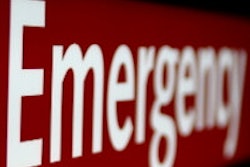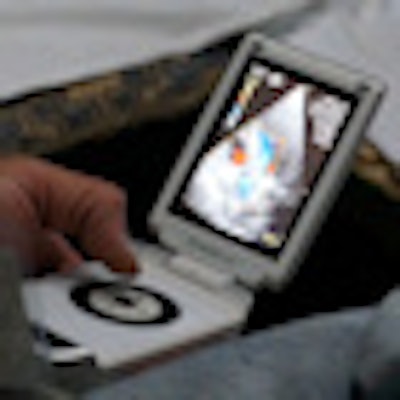
Surrounded by an estimated 12 million pilgrims gathered for a spiritual celebration, a clinical mission to India sponsored by the American Society of Echocardiography (ASE) demonstrated the power of medical imaging and teleradiology by enabling cardiologists around the world to rapidly diagnose heart disease among patients examined with ultrasound thousands of miles away.
The gathering, which took place late January in Sirsa, an ancient spiritual center about 150 miles north of New Delhi, produced the necessary field conditions for ASE's Focus on India program, which combined echocardiography and teleradiology for a large underserved population, according to team leader Dr. Partho Sengupta, a senior cardiologist at Mount Sinai Medical Center in New York City.
"Cardiac screening has never before been taken to this magnitude, going to the heart of a community in a remote region of India to prioritize the health needs of the underserved," Sengupta told AuntMinnie.com.
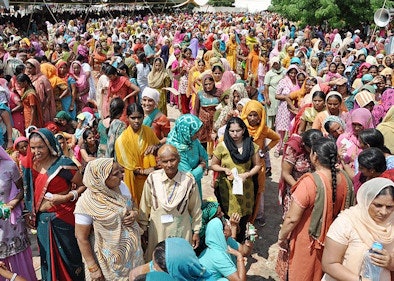 |
| A throng of women is representative of the 12 million people who gathered for a mass meditation in Sirsa to celebrate the birthday of spiritual leader Shah Satnam Ji. Image courtesy of GE Healthcare. |
With help from healthcare staff from Medanta - The Medicity hospital near New Delhi, ASE volunteers screened thousands for symptoms of heart disease. From that total, 1,040 symptomatic individuals underwent echocardiography performed with a handheld ultrasound scanner (Vscan, GE Healthcare).
Studies were then transmitted via a broadband Internet connection to a cloud where they were downloaded for interpretation by 75 volunteer cardiologists in Australia, Bulgaria, the Republic of Georgia, Greece, Saudi Arabia, and the U.S. Reports were transmitted back to India, where they were delivered to patients within eight hours of imaging. All patient services were provided for no cost.
"This was the ultimate stress test for echocardiography by telemedicine," said Dr. James Thomas, president of ASE. "Just working out the logistics taught us a lot about how we can do telemedicine in the future."
A land of unmet needs
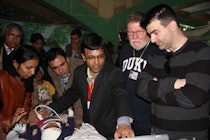 U.S. and Indian participants in the Focus on India project watch program organizer Dr. Partho Sengupta perform an echocardiogram during the mass screening in Sirsa, India, on January 25. Image courtesy of ASE.
U.S. and Indian participants in the Focus on India project watch program organizer Dr. Partho Sengupta perform an echocardiogram during the mass screening in Sirsa, India, on January 25. Image courtesy of ASE.
A native of Nagpur, India, Sengupta learned about the unmet medical needs of north central India during a cardiology fellowship at the All India Institute of Medical Sciences in New Delhi. The idea of an international mission germinated during subsequent cardiovascular fellowships at the Mayo Clinic in Rochester, MN, and Scottsdale, AZ.
Sengupta established the framework for the recent mission after an ASE-sponsored pilot program at the Sirsa meditational gathering in 2011. A mass screening was possible this year because of a $40,000 grant from GE Healthcare, which provided 10 of the Vscan devices and two full-featured laptop scanners. GE personnel at the site maintained the equipment and Internet connections.
About 200 sonographers responded to ASE's call for nine ultrasound technologists to travel to Sirsa to perform the echo exams on a volunteer basis. Andrea Van Hoever, ASE vice president of research, served as the society's technical troubleshooter for remote reading and interpretation.
Rhonda Price, director of international relations, addressed logistical issues, including the presentation of an ASE humanitarian award to Shah Satnam Ji, the spiritual leader responsible for the massive meditation gathering and the society's host in Sirsa.
"We also came up with an abundance of physicians who were able to carve out time from their workday without having to go anywhere to participate in the mission," said Dr. Patricia Pellikka, ASE president-elect. "They were able to pull images from the cloud and read them."
 Clinical services were strictly segregated by gender during ASE's Focus on India event. Sonographer Sue Maisey is shown performing an echocardiogram in the women's clinic. Image courtesy of ASE.
Clinical services were strictly segregated by gender during ASE's Focus on India event. Sonographer Sue Maisey is shown performing an echocardiogram in the women's clinic. Image courtesy of ASE.
The mobile clinic at Sirsa was set up in a clean and well-lit -- though often chilly -- warehouse. In deference to regional tradition, separate examination areas were established for men and women. Procedures were performed continuously for 10 hours, with operations closing down at about 11 p.m. each day.
Medical aides handled patient preparation. Sonographers performed imaging with patients lying on sheet-covered cots. Technicians shuffled among the imaging stations each hour to replace batteries on the Vscan units. Studies were batched for transmission several times daily.
A typical 10-minute exam with Vscan involved standard 2D anatomic views and color Doppler blood-flow imaging to identify structural abnormalities, according to Sue Maisey, director of the noninvasive cardiology/arrhythmia center at St. Luke's Episcopal Hospital in Houston.
"The Vscan was perfect for the setting," she told AuntMinnie.com by email. "There was no time delay in entering patient data. It was quick and easy to use."
Complex cases, especially infants and children with suspected congenital abnormalities, were referred for spectral Doppler imaging on laptop-based scanners (Vivid i and Vivid q, GE Healthcare).
Despite the remote location, mission engineers made special arrangements to establish an extremely fast broadband connection to the site, according to ASE officials. Download and upload speeds of 30 Mbps were established during a speed test from the Sirsa clinical site to New Delhi. A subsequent test showed speeds of 1 Mbps to 5 Mbps from Sirsa to Dallas, the equivalent of top speeds possible with point-to-point cable connections of 1 Mbps to 6 Mbps in the U.S.
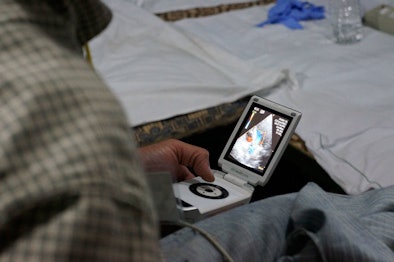 |
| A handheld echocardiography system (Vscan, GE Healthcare) shows color Doppler cardiac blood flow in a patient. Image courtesy of GE Healthcare. |
Studies were uploaded to an Internet cloud where volunteer cardiologists downloaded a predetermined number to fulfill a daily assignment. Thomas, Pellikka, and nine other faculty members at an annual ASE training session in Hawaii read 50 cases per day. Clinically interesting cases were then stripped of patient identification and presented to cardiologists attending continuing medical education (CME) classes later that day.
Some findings were astounding, Thomas said. In one instance, a ventricular septal defect appeared large enough to flood the patient's lungs and cause irreversible damage, but the patient also had severe pulmonic stenosis, which provided some pulmonary protection.
Clinicians identified several cases of severe rheumatic mitral stenosis among young patients.
"I had a patient with a valve area of 0.5 cm2," Thomas said. "This is almost unimaginable for a patient who could still walk, talk, and go to the meditation. He would have been operated on years ago if he lived in the U.S."
Other notable cases included a double-outlet right ventricle, a large patent ductus arteriosus, and several cases of ventricle and hypertensive cardiomyopathy.
A young boy with Down syndrome, examined with Vivid q, was sonographer David Adams' most memorable case. Adams, who practices at Duke University, anticipated seeing a congenital heart defect, a common condition among such patients, but the findings were unremarkable.
"A physician looked at the study, then told the family the good news," Adams told AuntMinnie.com. "Seeing their grateful faces was the highlight of the trip for me."





